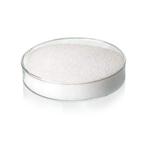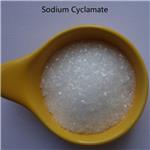- Sodium Cyclamate
-

- $0.00 / 1kg
-
2024-03-26
- CAS:139-05-9
- Min. Order: 1kg
- Purity: 99%
- Supply Ability: 20tons
- Sodium cyclamate
-

- $1.00 / 1KG
-
2023-11-05
- CAS:139-05-9
- Min. Order: 1KG
- Purity: 0.99
- Supply Ability: 1000 Tons
|
| | Sodium N-cyclohexylsulfamate Basic information |
| | Sodium N-cyclohexylsulfamate Chemical Properties |
| Melting point | >300 °C (lit.) | | density | 1.58[at 20℃] | | vapor pressure | 0.002Pa at 150℃ | | storage temp. | room temp | | solubility | 200g/l | | form | Powder | | color | White | | PH | 5.5-7.5 (100g/l, H2O, 20℃) | | Water Solubility | >=10 g/100 mL at 20 ºC | | Merck | 14,2703 | | BRN | 4166868 | | Stability: | Hygroscopic | | InChIKey | UDIPTWFVPPPURJ-UHFFFAOYSA-M | | LogP | -2.63 at 20℃ | | CAS DataBase Reference | 139-05-9(CAS DataBase Reference) | | IARC | 3 (Vol. Sup 7, 73) 1999 | | EPA Substance Registry System | Sodium cyclamate (139-05-9) |
| Hazard Codes | Xn | | Risk Statements | 22 | | Safety Statements | 36/37-24/25 | | WGK Germany | 3 | | RTECS | GV7350000 | | TSCA | Yes | | HS Code | 29299000 | | Toxicity | Sodium cyclamate is a non-nutritive sweetener
that is about 30 times sweeter than cane sugar. The oral LD50s
in rats and mice are 15.25 and 17.0 g/kg, respectively. It was
banned as a food additive because of findings that it caused
bladder cancer in rodents. It appears to act as a promoter.
There is also evidence that it causes toxicity in the male reproductive
system. |
| | Sodium N-cyclohexylsulfamate Usage And Synthesis |
| Chemical Properties | Sodium cyclamate occurs as white, odorless or almost odorless
crystals, or as a crystalline powder with an intensely sweet taste. | | Chemical Properties | White powder | | History | Cyclamate was first synthesized in 1937. Like the other sweeteners, its sweet taste was accidentally discovered (U.S. Pat. 2,275,125 (Mar. 3, 1942), L. F. Andrieth and M. Sveda (to E. I. du Pont de Nemours & Co., Inc.). The FDA in 1958 classified sodium cyclamate as a GRAS sweetener. In 1969, a 2-year chronic toxicity study with a sodium cyclamate–sodium saccharin (10:1) mixture found bladder tumors in rats. The FDA took cyclamate off the GRAS list, banning it from foods and beverages, but permitting its sale in pharmacies. In 1970, after a congressional investigation, the FDA banned the use of cyclamate entirely. Abbott Laboratories, which has conducted additional toxicity and carcinogenicity studies with cyclamate, a 10:1 mixture of cyclamate–saccharin, and cyclohexylamine, claimed to be unable to confirm the 1969 findings. Abbott then filed a food additive petition for cyclamate in 1973, which was denied by the FDA in 1980. In 1982, the Calorie Control Council and Abbott Laboratories filed a second food additive petition containing the results of additional safety studies (The Calorie Control Council and Abbott Laboratories, Food Additive Petition for cyclamate 2A3672 (Sept. 22, 1982). That petition remains active. | | Uses | Sodium Cyclamate is an artificial sweetener and is 30 times as saccharose's. It is widely used in pickles, seasoning sauce, cakes, biscuits, bread, ice cream, frozen sucker, popsicles, drinks and so on, with a maximum amount of 0.65g/kg. Secondly, it is used in confect, with a maximum amount of 1.0g/kg. Thirdly, it is used in orange peel, preserved plum, dried arbutus and so on, with the largest amount of 8.0g/kg. It is also used in cosmetics and pharmaceutical industry. | | Uses | Cyclamate (cyclohexylsulfamic acid and its calcium and sodium salts)
were discovered in the United States in 1937. They are 30 to 80 times
as sweet as sucrose and were widely used until late 1969, when it was banned by the FDA because of questions on safety. It is not banned in
Canada and the European Union.
Cyclamate is produced by reacting cyclohexylamine with sulfonating
agents, followed by reactions with sodium or calcium hydroxides to produce
cyclamates and free cyclohexylamine as follows.
Owing to their good stability, cyclamates are suitable for all applications
of intense sweeteners without a significant interfering taste sensation,
and are heat stable. The main application of cyclamates is in
blends with saccharin in a 10:1 ratio by weight. The mixture is more
than twice as sweet as either component alone, making them an important
sweetener in countries approving the use of both sweeteners. | | Production Methods | Cyclamates are prepared by the sulfonation of cyclohexylamine in
the presence of a base. Commercially, the sulfonation can involve
sulfamic acid, a sulfate salt, or sulfur trioxide. Tertiary bases such as
triethylamine or trimethylamine may be used as the condensing
agent. The amine salts of cyclamate that are produced are converted
to the sodium, calcium, potassium, or magnesium salt by treatment
with the appropriate metal oxide. | | Definition | ChEBI: Cyclamate is an organic molecular entity. | | Brand name | Adocyl;Ampenoline balsamoco;Assugrin;Azucrona;Cyclarin;Glusac super;Ilgon;Sladicin;Sucaryl calcium;Sucaryl sodium;Sucrum 7. | | World Health Organization (WHO) | Cyclamates, non-nutritive sweetening agents, have been used as
additives in food and drugs since 1950. They have been demonstrated to have a
carcinogenic potential at very high and long-sustained dosage in experimental
animals. Some countries have consequently banned their use as food additives,
whereas in others they remain available for this purpose. Most countries, however,
continue to allow their use in small quantities in pharmaceutical preparations.
(Reference: (WHODI) WHO Drug Information, 77.2, 12, 1977) | | General Description | Odorless or almost odorless white crystals or crystalline powder. Intensely sweet taste, even in dilute solution. pH (10% solution in water): 5.5-7.5. Used as a non-nutritive sweetener. | | Air & Water Reactions | Water soluble. | | Reactivity Profile | Sodium N-cyclohexylsulfamate is incompatible with strong oxidizing agents, strong acids and strong bases. Also incompatible with nitrites in acid solution. Has only limited compatibility with potassium salts . | | Hazard | Some evidence of causing cancer in lab-
oratory animals. Prohibited by FDA for food use.
Questionable carcinogen. | | Fire Hazard | Flash point data for Sodium N-cyclohexylsulfamate are not available; however, Sodium N-cyclohexylsulfamate is probably combustible. | | Flammability and Explosibility | Not classified | | Pharmaceutical Applications | Sodium cyclamate is used as an intense sweetening agent in
pharmaceutical formulations, foods, beverages, and table-top
sweeteners. In dilute solution, up to about 0.17% w/v, the
sweetening power is approximately 30 times that of sucrose.
However, at higher concentrations this is reduced and at a
concentration of 0.5% w/v a bitter taste becomes noticeable.
Sodium cyclamate enhances flavor systems and can be used to mask
some unpleasant taste characteristics. In most applications, sodium
cyclamate is used in combination with saccharin, often in a ratio of
10 : 1. | | Biochem/physiol Actions | Phenylsulfamate sweet tastant detectable by humans. ′First generation′ sweetener studied in animal models for its carcinogenic potential. | | Toxicology | Sodium cyclamate is an odorless powder. It is about 30 times as sweet as sucrose in dilute solution. The structure of sodium cyclamate is shown in Figure 10.10 Capillary transitional cell tumors were found in the urinary bladders of 8 out of 80 rats that received 2600 mg/kg body weight per day of a mixture of sodium cyclamate and sodium saccharin (10:1) for up to 105 weeks. When the test mixture was fed at dietary levels designed to furnish 500, 1120, and 2500 mg/ kg body weight to groups of 35 and 45 female rats, the only significant finding was the occurrence of papillar carcinomas in the bladders of 12 of 70 rats fed the maximum dietary level of the mixture (equivalent of about 25 g/kg body weight) for periods ranging from 78 to 105 weeks (except for one earlier death). In vivo conversion from sodium cyclamate to cyclohexylamine was observed particularly in the higher dosage group. Cyclohexylamine is very toxic (LD50 rat oral=157 mg/dg) compared to sodium cyclamate (LD50 oral=12g/kg). | | Safety Profile | Moderately toxic by intravenous and intraperitoneal routes. Mildly toxic by ingestion. Experimental reproductive effects. Questionable carcinogen with experimental neoplastigenic, tumorigenic, and teratogenic data. Human mutation data reported. When heated to decomposition it emits very toxic fumes of NazO, SOx, and NOx. | | Safety | There has been considerable controversy concerning the safety of
cyclamate following the FDA decision in 1970 to ban its use in the
USA. This decision resulted from a feeding study in rats that
suggested that cyclamate could cause an unusual form of bladder
cancer. However, that study has been criticized because it involved
very high doses of cyclamate administered with saccharin, which
has itself been the subject of controversy concerning its safety; see
Saccharin. Although excreted almost entirely unchanged in the
urine, a potentially harmful metabolite of sodium cyclamate,
cyclohexylamine, has been detected in humans. In addition, there
is evidence to suggest cyclamate is metabolized to cyclohexylamine
by the microflora in the large intestine of some individuals
(approximately 25% of the population with higher precedence in
Japanese than Europeans or North Americans). Cyclohexylamine,
following absorption, is metabolized to an extent of 1-2% to
cyclohexanol and cyclohexane-1,2-diol. Established no-observedeffect
level (NOEL) and acceptable daily intake (ADI) values are
based on cyclohexylamine levels of high cyclamate converters.(6,7)
Extensive long-term animal feeding studies and epidemiological
studies in humans have failed to show any evidence that cyclamate
is carcinogenic or mutagenic. As a result, sodium cyclamate is
now accepted in many countries for use in foods and pharmaceutical
formulations.
Few adverse reactions to cyclamate have been reported,
although its use has been associated with instances of photosensitive
dermatitis.
The WHO has set an estimated acceptable daily intake for
sodium and calcium cyclamate, expressed as cyclamic acid, at up to
11 mg/kg body-weight. In Europe, a temporary acceptable daily
intake for sodium and calcium cyclamate, expressed as cyclamic
acid, has been set at up to 1.5 mg/kg body-weight.
LD50 (mouse, IP): 1.15 g/kg
LD50 (mouse, IV): 4.8 g/kg
LD50 (mouse, oral): 17 g/kg
LD50 (rat, IP): 1.35 g/kg
LD50 (rat, IV): 3.5 g/kg
LD50 (rat, oral): 15.25 g/kg | | storage | Sodium cyclamate is hydrolyzed by sulfuric acid and cyclohexylamine
at a very slow rate that is proportional to the hydrogen ion
concentration. Therefore, for all practical considerations, it can be
regarded as stable. Solutions are also stable to heat, light, and air
over a wide pH range.
Samples of tablets containing sodium cyclamate and saccharin
have shown no loss in sweetening power following storage for up to
20 years.
The bulk material should be stored in a well-closed container in a
cool, dry place. | | Application | Sodium
N-cyclohexylsulfamate (SCHS) dissolved in the aqueous phase
could be introduced as the additive during the interfacial polymerization process. SCHS could not only improve the hydrophilicity and flux of the membrane, but also could enhance the
anti-fouling properties of the membrane[1]. | | References | [1] Chen G, et al. Fabrication and characterization of a novel nanofiltration membrane by the interfacial polymerization of 1,4-diaminocyclohexane (DCH) and trimesoyl chloride (TMC). RSC Advances, 2015; 5: 40742-40752. | | Regulatory Status | The use of cyclamates as artificial sweetners in food, soft drinks, and
artificial sweetening tablets was at one time prohibited in the UK
and some other countries owing to concern about the metabolite cyclohexylamine. However, this is no longer the case, and
cyclamates are now permitted for use as a food additive in Europe.
Included in the FDA Inactive Ingredients Database (oral powder,
solutions, chewable tablets, and suspensions). Included in nonparenteral
medicines licensed in the UK. Included in the Canadian List
of Acceptable Non-medicinal Ingredients. |
| | Sodium N-cyclohexylsulfamate Preparation Products And Raw materials |
|